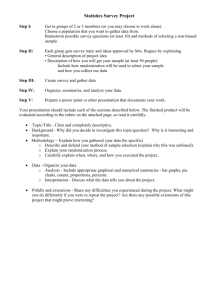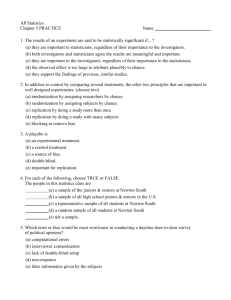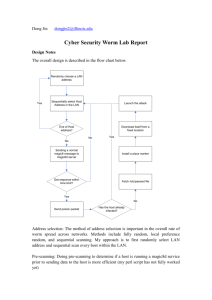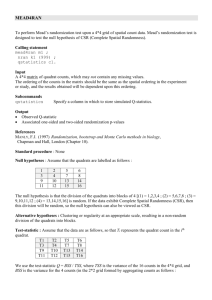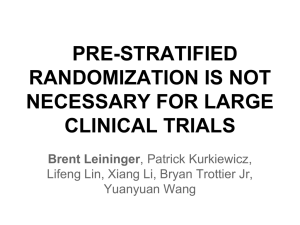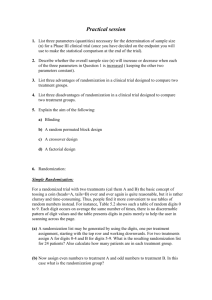EVIDENCE BASED CLINICAL PRACTICE
advertisement
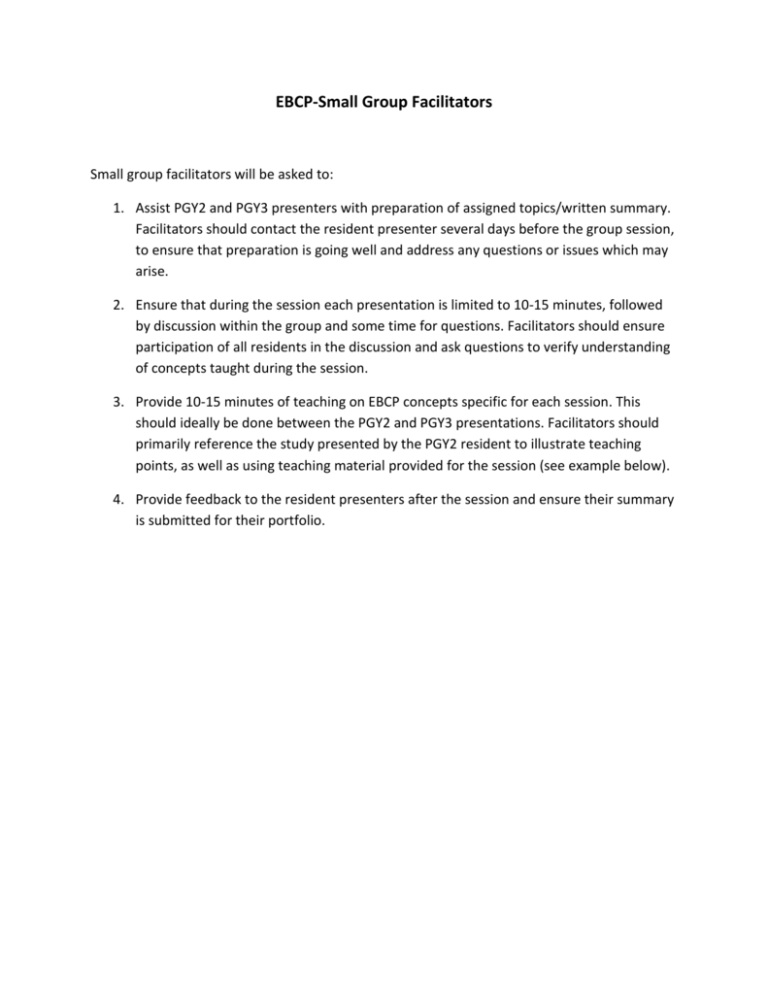
EBCP-Small Group Facilitators Small group facilitators will be asked to: 1. Assist PGY2 and PGY3 presenters with preparation of assigned topics/written summary. Facilitators should contact the resident presenter several days before the group session, to ensure that preparation is going well and address any questions or issues which may arise. 2. Ensure that during the session each presentation is limited to 10-15 minutes, followed by discussion within the group and some time for questions. Facilitators should ensure participation of all residents in the discussion and ask questions to verify understanding of concepts taught during the session. 3. Provide 10-15 minutes of teaching on EBCP concepts specific for each session. This should ideally be done between the PGY2 and PGY3 presentations. Facilitators should primarily reference the study presented by the PGY2 resident to illustrate teaching points, as well as using teaching material provided for the session (see example below). 4. Provide feedback to the resident presenters after the session and ensure their summary is submitted for their portfolio. EVIDENCE BASED CLINICAL PRACTICE Randomized Controlled Trials Part I: Applicability/External Validity, Randomization, Blinding Framework for appraisal of Randomized Controlled Trials (RCTs) Applicability or External Validity Randomization Blinding (Masking) Would my patient be a candidate for this study? Was randomization/allocation concealed? Who was masked? Participants Health care providers Is there any significant reason why study results may not apply to my patient? Was it successful? Data collectors and analysts Outcome adjudicators etc How successful was masking of the participants? Follow up Analysis Outcomes Duration: How were missing data handled? Were patient oriented outcomes examined? Intention to Treat analysis If used, do surrogate outcomes correlate well with patient oriented outcomes? Was the duration of the study adequate for expected benefits and harms to fully manifest? Completeness: How many patients were lost to follow up (drop-outs)? Per Protocol analysis As treated analysis Were adverse effects and cost issues examined or discussed? 1. Applicability or external validity Research studies frequently employ strict inclusion and exclusion criteria and take place in “ideal” settings which may be quite different from usual clinical settings. Strict inclusion and exclusion criteria do not invalidate the results of the study but may limit the applicability/generalizability of its results. It has been reported (1) that only about 1 in 5 patients with osteoporosis from a large academic center would have been accepted in large RCTs on the topic. Patients may be excluded from trials because of age, gender, literacy status, severity of illness, multiple co-morbidities etc Trial settings are frequently resource plenty and involve investigators with high expertise. These settings may not be easily replicated in usual practice. A study (2) showed additional value of clinical breast examination to mammograms for detecting breast cancer, with the caveat that the study employed highly trained nurses who spent on average 8-10 minutes performing clinical breast examinations. Healthcare providers should ask themselves a twofold question: “Are the study settings and patients similar to my practice?” and if not “Is that a significant enough reason to not apply the results to my patient?” 2. Randomization Randomization indicates that allocation of patients to different groups is determined by chance alone. Proper randomization reduces the effect of “confounding factors”, which are known or unknown variables that may affect the outcome of interest. Without proper randomization patients with worse prognosis may preferentially be assigned to one group or the other (allocation bias), “confounding” the results of the study. Allocation or randomization concealment prevents undue influence on the randomization process by study investigators and participants (for example by opening the envelope and then deciding whether to enroll the patient in the study or not). In order to assess the randomization process, readers should look for the following: a. Detailed description of the method used to generate a random allocation sequence and to ensure allocation concealment. One may clearly note a difference in the following descriptions of randomization: “This was a randomized controlled trial” “Patients who fulfilled all the entry criteria were randomly assigned in a 1:1 ratio” “Random allocation of the study treatments involved sequentiallynumbered sealed treatment packs prepared centrally” “A research associate, not a member of the research team, prepared the randomization code using a computer generated random allocation schedule in three unequal blocks. The external pharmaceutical company then sealed the study drugs in sequentially numbered identical containers according to the allocation sequence. All members of the research team—investigators, project coordinator, physicians, patient educators, research assistants, data collectors, data-entry staff, and the research pharmacist who dispensed all study drugs in sequence—were unaware of the allocation schedule” b. The table of baseline characteristics (usually table 1). Although differences in baseline characteristics may occur by chance alone, multiple or large differences should raise concerns regarding the prognostic balance of the groups. 3. Blinding/masking Properly done randomization ensures that prognostic characteristics of study groups are the same at the beginning of the study. To ensure that prognosis of different groups remains the same, after the study has started, study participants should remain unaware of treatment assignments (blinding or masking). Non-blinded (open-label) studies frequently lead to bias favoring the intervention. Open-label trials of kyphoplasty and vertebroplasty for vertebral compression fractures, showed reduction in patient reported pain and improvement in physical function. Subsequently, two double-blinded RCTs , comparing vertebroplasty with sham procedures showed no benefit in pain, quality of life or disability (3). Double blinded studies refer to masking of both the patients and investigators while single blinded studies suggest masking of patients. Outcome assessors should also be masked (triple blinded) as well as all others involved (data collectors, data analysts, data safety and monitoring committee, study writers). Masking prevents performance bias (participants behavior influenced by knowledge of the intervention used) and ascertainment bias (detection or reporting of outcomes is influenced by knowledge of the intervention used) Masking is achieved to a large degree by using placebo interventions. It may be difficult or even impossible in surgical trials, dietary or educational interventions and in other circumstances where effects of the intervention may be apparent, even with the use of placebo (eg chemotherapy, b-blockers). REFERENCES 1. Dowd R, Recker RR, Heaney RP. Study subjects and ordinary patients. Osteoporos Int. 2000;11:533-536 2. Chiarelli AM et al. The contribution of clinical breast examination to the accuracy of breast screening. J Natl Cancer Inst 2009 Sep 16; 101:1236 3. Kristine E. Ensrud, MD, MPH. John T. Schousboe, MD, PhD. Vertebral fractures. N Engl J Med 364;17, Apr 28, 2011 4. Jadad AR, Enkin MW. Randomized Controlled Trials. Questions, Answers and Musings. BMJ Books
